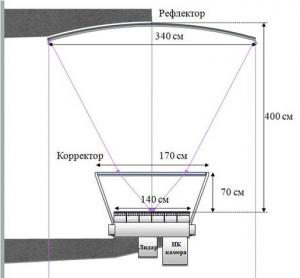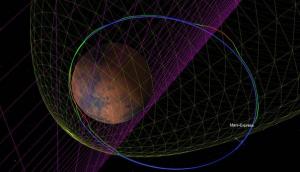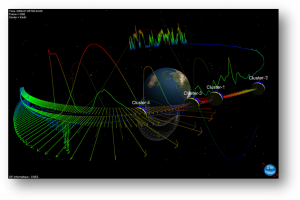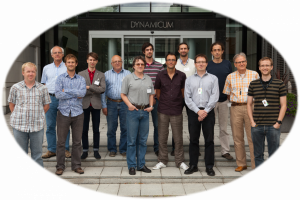The FP7-SPACE project IMPEx (http://impex-fp7.oeaw.ac.at) was established as a result of scientific collaboration between several research teams from Austria, Finland, France, and Russia, working on the integration of a set of interactive data mining, analysis and modeling tools in the field of space plasma and planetary physics. The major goal of the project is, to bridge the gap between spacecraft measurements and modern computational models of the planetary near-by space environments, enabling their joint interconnected operation for better understanding of related physical phenomena. The interactive computational framework and integrated research infrastructure being developed in the course of the IMPEx project, is comprised of numerical Hybrid/MHD (Fig.1) and analytical Paraboloid-magnetosphere (Fig.2) models, as well as of the data mining, visualization, and analysis tools: AMDA, 3DView (Fig.3), and ClWeb (http://impex-fp7.oeaw.ac.at/tools.html).

Figure 1: Computational modelling of planetary magnetospheres with the 3D Hybrid model platform (HYB) from the Finnish Meteorological Institute (FMI)

Figure 2: Magnetosphere of the Earth simulated with the on-line Terrestrial Paraboloid magnetosphere model from Skobeltsin Institute of Nuclear Physics (SINP) of Moscow State University

Figure 3: Space plasma environment model from CNRS/LATMOS along the Mars-Express (ESA) orbit and visualized in 3DView (CNRS/CDPP)

Figure 4: Magnetic field environment along the Cluster (ESA) orbit and visualized in 3DView (CNRS/CDPP)
The major challenge of the current phase of IMPEx development consists in the need to connect different types of data sources, including numerical simulation results and observational data, in order to give IMPEx users the possibility to analyze and visualize the respective data by means of interactive web-based project tools. One of the systems’ cornerstones is the specification of a standard for describing the various data products involved (e.g., simulations and observations) within a common standard, e.g. Data Model (DM). The newly developed IMPEx DM extends the known SPASE DM which is already widely used, to describe observational data in space plasma research.
To meet the requirement of extendibility, i.e. to have a possibility to include new computational models and analysis / visualization tools, the IMPEx DM as well as communication protocols have been designed to be as compact as possible and yet general and powerful enough to incorporate a wide range of data sets and to allow for simple procedures when attaching new components to the system. The test version of the IMPEx DM that is currently still in development was presented on several recent international scientific conferences and recognized by professionals in the field as an important contribution and a sound starting point on the way of developing of a unified approach to work with experimental and computationally modelled scientific data.

The IMPEx project international team. (From left to the right: S. Dyadechkin, W.Schmidt, N. André, F.Topf, I. Alexeev, M. Khodachenko, R.Stöckler, V. Génot, R.Modolo, E.Kallio, T. Al-Ubaidi, M.Gangloff, R. Järvinen,).
IMPEx core team contact details
Coordinator - M. Khodachenko (IWF-ÖAW, Austria, maxim.khodachenko@oeaw.ac.at, +43 316 41 20 661);
Deputy-Coordinator - E. Kallio (FMI, Finland, esa.kallio@fmi.fi, +358 29 539 46 36);
Project Scientist - V. Génot (CNRS/IRAP, France, vincent.genot@irap.omp.eu, +33 5 61 55 85 54);
Project manager - T. Al-Ubaidi (IWF-ÖAW, Austria, tarek.al-ubaidi@oeaw.ac.at, +43 316 41 20 673);
Work Package Leader - M. Gangloff (CNRS/IRAP, France, michel.gangloff@irap.omp.eu);
Work Package Leader - W.Schmidt (FMI, Finland, walter.schmidt@fmi.fi, +358 29 539 46 58);
Work Package Leader - I. Alexeev (SINP-MSU, Russia, alexeev@dec1.sinp.msu.ru, +7 495 939 10 36).
Site: http://impex-fp7.oeaw.ac.at
Structure units:
